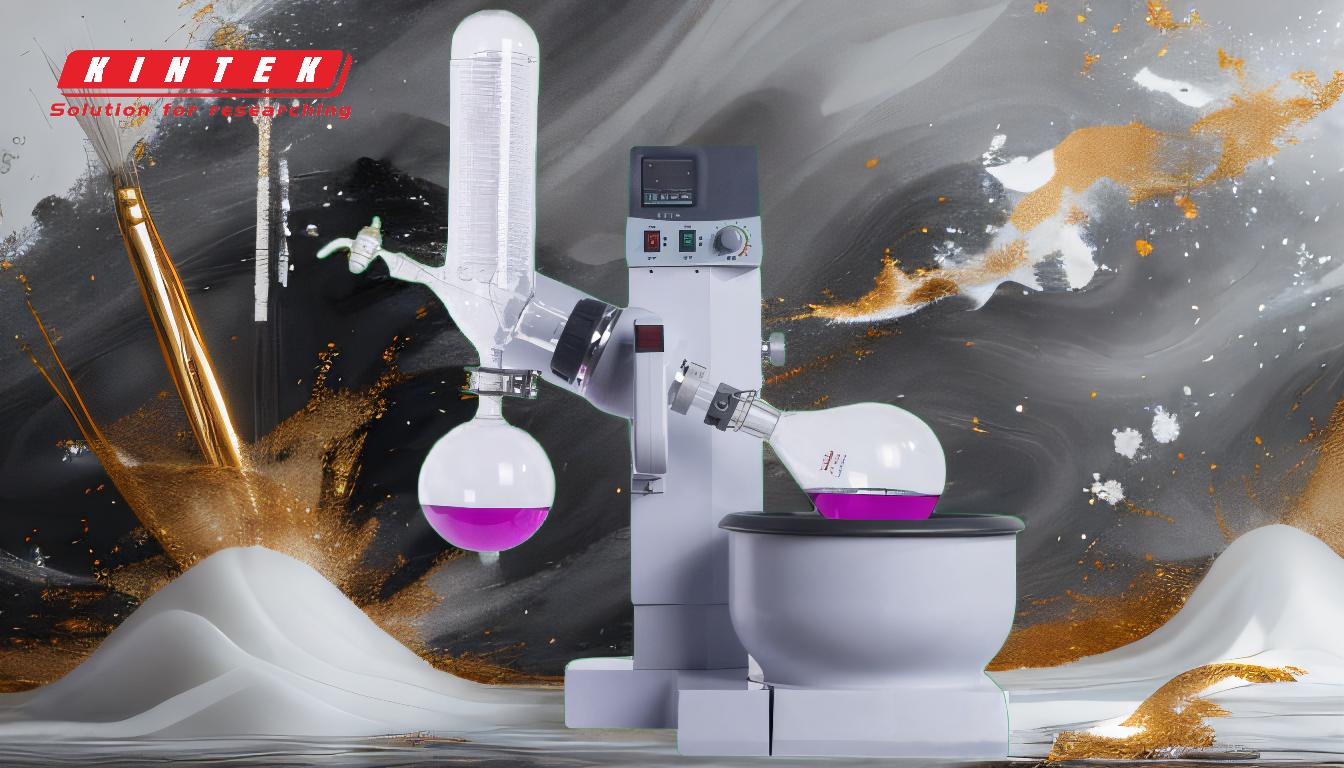Rotary evaporation is a widely used laboratory technique for the efficient and gentle removal of solvents from samples. It operates under reduced pressure, which lowers the boiling point of the solvent, allowing evaporation to occur at lower temperatures. The process involves rotating a flask containing the sample in a heated water or oil bath, creating a thin film on the flask's interior surface. This thin film increases the surface area for evaporation, while a vacuum system reduces the pressure to facilitate rapid solvent removal. The evaporated solvent is then condensed in a chilled condenser and collected in a separate flask. This method is particularly useful for concentrating heat-sensitive compounds or isolating solvents from mixtures without causing degradation.
Key Points Explained:

-
Purpose of Rotary Evaporation:
- Rotary evaporation is primarily used to remove solvents from samples, reducing the volume of the solution while preserving the integrity of heat-sensitive compounds.
- It is particularly effective for isolating solvents from mixtures, concentrating solutions, or recovering solvents for reuse.
-
Key Components of a Rotary Evaporator:
- Distilling Flask: Holds the sample and is rotated to create a thin film on its interior surface, enhancing evaporation.
- Heating Bath: Typically filled with water or oil, it heats the sample to a controlled temperature (usually 30-40°C) to facilitate evaporation.
- Condenser: Chilled to temperatures between -10°C and 0°C, it recondenses the evaporated solvent vapors back into liquid form.
- Vacuum Pump: Reduces the pressure inside the system, lowering the boiling point of the solvent and enabling evaporation at lower temperatures.
- Motor Unit: Rotates the distilling flask at speeds of 150-200 rpm to ensure uniform evaporation.
- Vapor Duct: Acts as a vacuum-tight conduit for vapor flow and serves as the axis for flask rotation.
- Condensate-Collecting Flask: Collects the recondensed solvent after it passes through the condenser.
-
Working Principle:
- The sample is placed in the distilling flask, which is partially submerged in the heated bath.
- The flask is rotated, creating a thin film of the sample on its interior surface, which increases the surface area for evaporation.
- A vacuum is applied to lower the pressure, reducing the solvent's boiling point and allowing it to evaporate at a lower temperature.
- The solvent vapors travel through the vapor duct to the condenser, where they are cooled and recondensed into liquid form.
- The condensed solvent is collected in the condensate flask, while the concentrated sample remains in the distilling flask.
-
Advantages of Rotary Evaporation:
- Gentle Evaporation: The reduced pressure and controlled heating prevent thermal degradation of heat-sensitive compounds.
- Efficiency: The thin film created by rotation maximizes the surface area for evaporation, speeding up the process.
- Solvent Recovery: The condensed solvent can be collected and reused, reducing waste and costs.
- Versatility: Suitable for a wide range of solvents and sample types.
-
Applications:
- Chemistry Labs: Used for concentrating solutions, isolating compounds, and purifying solvents.
- Pharmaceutical Industry: Essential for drug development and purification processes.
- Food and Flavor Industry: Used to extract and concentrate flavors and fragrances.
- Environmental Analysis: Helps in concentrating samples for trace analysis.
-
Operational Considerations:
- Sample Volume: The distilling flask should not be filled beyond 50% capacity to ensure efficient evaporation and prevent bumping.
- Temperature Control: The heating bath temperature must be carefully regulated to avoid overheating the sample.
- Vacuum Level: The vacuum pump should be adjusted to achieve the optimal pressure for the solvent being evaporated.
- Rotation Speed: A speed of 150-200 rpm is typically used to create an even thin film without causing splashing.
-
Accessories and Enhancements:
- Beaker Flask with Larger Opening: Facilitates easier loading and cleaning of the sample.
- Foam Sensor: Detects foam formation, which can interfere with the evaporation process.
- Chiller with Ethylene Glycol: Maintains consistent condenser temperatures for efficient solvent recondensation.
By understanding the components, principles, and operational considerations of rotary evaporation, users can effectively apply this technique in various laboratory and industrial settings to achieve precise and efficient solvent removal.
Summary Table:
| Aspect | Details |
|---|---|
| Purpose | Removes solvents, concentrates solutions, and recovers solvents for reuse. |
| Key Components | Distilling flask, heating bath, condenser, vacuum pump, motor unit, etc. |
| Working Principle | Rotates flask to create a thin film; reduces pressure for lower evaporation. |
| Advantages | Gentle evaporation, high efficiency, solvent recovery, and versatility. |
| Applications | Chemistry labs, pharmaceuticals, food/flavor industry, environmental analysis. |
| Operational Tips | Control sample volume, temperature, vacuum level, and rotation speed. |
| Accessories | Beaker flask, foam sensor, chiller with ethylene glycol. |
Discover how rotary evaporation can optimize your lab processes—contact us today for expert advice!












